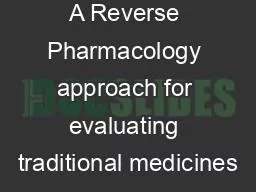

in the Republic of Palau to improve the management of obesitylinked diabetes Aim An important recommendation of the World Health Organization is the evaluation of traditional medicines Reverse Pharmacology ID: 798968
Download The PPT/PDF document "A Reverse Pharmacology approach for eval..." is the property of its rightful owner. Permission is granted to download and print the materials on this web site for personal, non-commercial use only, and to display it on your personal computer provided you do not modify the materials and that you retain all copyright notices contained in the materials. By downloading content from our website, you accept the terms of this agreement.
Slide1
A Reverse Pharmacology approach for evaluating traditional medicines
in the Republic of Palau
to improve the management of obesity-linked diabetes
Aim
An important recommendation of the World Health Organization is the evaluation of traditional medicines.
Reverse Pharmacology
is an
ethnopharmacological
methodology which aims precisely to evaluate traditional practices [1].It includes three main stages:Selection of medicinal herbsClinical evaluationLaboratory studiesA reverse pharmacology approach was implemented in the Republic of Palau to improve the management of Non-Communicable Diseases.
References
Icons from Noun Project: Gan Khoon Lay (overweight humans), Corpus delicti (Choose pharmacy), Eucalyp (diabetes), Wilson Joseph (population), Juan Manueal Corredor (human), Dinosoft Labs (agreement), Alina Oleynik (mouse), Juraj Sedlka (molecule), Meaghan Hendricks (future), Gan Khoon Lay (advantages).
Acknowledgments
Joëlle Houriet1, Christopher Kitalong2, Renata Campos Nogueira3, Carla Rudigier4, Jeanne Benichou5, Victor Yano2, Vanessa Espangel2, Pearl L. Marumoto2, Josepha Tiobech2, Christian Wolfrum4, Jean-Luc Wolfender1, Bertrand Graz2, 3
Declaration of
State of Emergency on Non-Communicable Diseases in 2011 (obesity-linked diseases, i.e. diabetes and hypertension).
Republic of Palau (Micronesia, Pacific ocean)
Clinical study on non-treated diabetic patients, compared to the standard first-line treatment.
Identification of the bioactive components to select markers for standardization and quality control.
Prevalence of overweight and obese adults of around 80 %, according to WHO data.
State of Emergency
Willcox
M., et al., A "reverse pharmacology" approach for developing an anti-malarial phytomedicine. Malar J, 2011. 10 Suppl 1: p. S8.Graz B., et al., Screening of traditional herbal medicine: First, do a retrospective study, with correlation between diverse treatments used and reported patient outcome. J Ethnopharmacol, 2005. 101(1–3): p. 338-339.Graz B., et al., Traditional local medicines in the republic of Palau and non-communicable diseases (NCD), signs of effectiveness. J Ethnopharmacol, 2015. 161: p. 233-7.Kitalong C., et al., "DAK", a traditional decoction in Palau, as adjuvant for patients with insufficient control of diabetes mellitus type II. J Ethnopharmacol, 2017. 205: p. 116-122.Kitalong C., et al., Phenolics from Phaleria nisidai with Estrogenic Activity. Records of Natural Products, 2012. 6(3): p. 296-300.
Contact
Jo
ëlle
Hourietjoelle.houriet@unige.ch
Advantages of the Reverse Pharmacology
This study succeeded in identifying a promising herbal medicine to improve diabetes control.
Valorization of traditional medicine made by the population.
Prioritization of the clinical evaluation of the selected medicinal herb at the beginning of the drug development process [1].Highly valuable post-clinical laboratory studies thanks to the preliminary clinical evaluation.Low cost compared to the classic drug development approach [1].
A
Material
Transfer Agreement (MTA)
was
established between the Pacific Academic Institute of Research (PAIR) and both universities.
Phytochemistry
Mice fed a high fat diet with the freeze-dried drink showed: Greater sensitivity to insulinImproved glucose toleranceHigher insulin secretion
Bioactivity
The freeze-dried drink is characterized by a high amount of the C-glycoside xanthone mangiferin and other minor related xanthones [5].
3. Laboratory studies
Material
Transfer Agreement
2.
Clinical
evaluation
This first clinical study ever organized in Palau was designed as a pilot randomized, double-blind, crossover clinical study.
The drink of
Phaleria nisidai was evaluated as an an adjuvant therapy for patients with insufficient diabetes control [4].
Key results
Patients with insufficient diabetes control improved their
glycemia during the clinical study (reduction of HbA1C). Decreased blood pressure and weight reduction were also observed [4].
Study
design
The drink of the
leaves
of
Phaleria
nisidai (thymelaeaceae) positively correlated with the lower blood sugar criterion. This drink is also called by the Palauan population Delal A Kar, the Mother of medicine [3].
Selection by a Retrospective Treatment Outcome (RTO) method. RTO statistically identified the remedies correlating with the best clinical outcomes [2].
Selection method
Selected herb
1.
Selection
of
medicinal herbs
Future steps
1
School of Pharmaceutical Sciences, University of Geneva, University of Lausanne, Rue Michel-
Servet
1, 1206 Geneva, Switzerland
2
Pacific Academic Institute for Research, 822
Ernguul
Rd., Koror, Palau
3
Antenna Foundation, Avenue de la Grenade 24, 1207 Geneva, Switzerland
4
Institute of Food, Nutrition and Health, ETH Zurich,
Schorenstrasse
16, CH-8603
Schwerzenbach
, Switzerland
.
5
ENSAT-National Institute of Agronomy and Environment of Toulouse, Avenue de
l’Agrobiopole
, BP 32607
Auzeville-Tolosane
, France